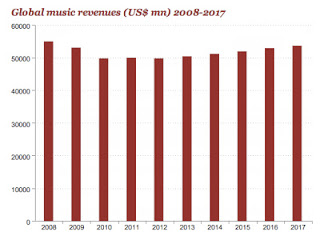When we all look into the same house through different windows it should
not be a surprise that we may all see different things. It’s the same house
just different perspectives.
Pricewaterhouse Coopers have just issued a report predicting a 1% annual
growth for the US-based music industry through to 2017. That may put a
smile back on the music executives, who are ready to slit their wrist and could
only see terminal decline. It may disappoint those optimists who believe that
music has turned the corner and would have expected a significant upturn. However,
for many it confirms that the traditional music industry after 100 years of stellar
growth is now seriously flat lining.
Before we all jump in to defend our own viewpoint, we have to accept that
the music industry is going through dramatic change in formats, channels,
culture, and how consumers listen, store and pay for music. It would be somewhat
foolish to predict the outcome in such turmoil. Who will survive and even what
the market may look like in the next decade is open to many prespectives,
interests and even down to the extent that the current culture will change.
Today, digital sales may be increasing, but the value of the units sold is
dropping. Digital sales may still be in their infancy, but are now under
serious threat as Apple’s favour nation starts to faulter, the challenge to
resell digital has only just begun and the demand streamed and subscription
services is only starting to redefine ownership. Even the relatively new swing
from album to singles, which was driven by the likes of iTunes, may not be as
clear cut as once predicted and the single versus the album debate is ongoing for
many. All this without the introduction of Neil Young’s Pono service which may
not happen, but is bound to be followed by others who are wanting better
quality than MP3.
If we look at through Pricewaterhouse Coopers’ revenue window we see a
flat business.
Pricewaterhouse Coopers predict grow in 2013, but based exactly on what?
Physical sales are falling and not being
compensated by digital sales and even the return of vinyl can only be seen as
niche. Kids are increasingly now turning to YouTube to watch and listen and
even if these licences were revisited they would never bring back the glory
days. We see from the recent Apple iRadio negotiations that although the streaming
business appears to be sound it will not feed all the production mouths that
have been built up over the good days.
If we look through another Pricewaterhouse Coopers’ window that shows
the comparative revenues generated by digital as opposed to physical we see a
sick physical patient and a digitally challenged one.
When we look at live revenues the Pricewaterhouse Coopers’ perspective is
more bullish and predicts a 3% growth to some $30.9 million by 2017. They
state that this will "more than offset the continued decline in recorded
music revenues." The question they fail to answer is whether this money
and growth will be owned by the traditional gang of three majors, or now
migrate to others such as Live Nation?
The question also exists about the division between publisher revenues
and recorded revenues and how that split will grow as streaming services grow.
It’s easy to look at music and see a sector that is struggling to compensate
and balance the loss of traditional physical sales revenues with the emerging
digital ones but it’s harder to see how music will generate the same revenues
it once did. It’s the same house but today even the foundations are changing!




No comments:
Post a Comment